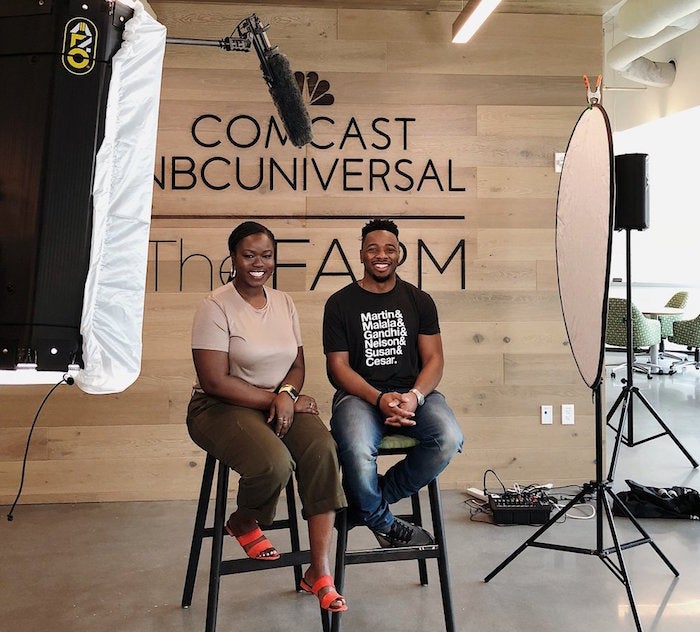 (Photo by Rich Fury/Getty Images for Mercedes-Benz and Glamour)
(Photo by Rich Fury/Getty Images for Mercedes-Benz and Glamour)
As we enter this new decade, many of us are thinking about how we can let go of people, places and things that no longer serve us. And atop that list is: Job. Whether we are preparing to be full-time entrepreneurs, we’ve lost joy and excitement from our work, or we are over toxic work environments, there’s no better time to map out your exit strategy and make room for the career you want for yourself.
The time is now, but before making any strides towards your next endeavor, it’s always essential to make a plan to help you transition into your future role or business idea. Here are four women who have made their exit from a company or position and their advice on taking that leap:
 Angela Manuel-Davis, photo courtesy of Getty.
Angela Manuel-Davis, photo courtesy of Getty.
Understand you have the right to grow
“What’s in front of us is greater than what’s behind us. Put in the atmosphere any and everything you can imagine that you hope and want for yourself!” Angela Manuel-Davis instructed a group of around 36 women to push their arms up towards the sky and with their eyes closed pull their arms up and down to grab hold of their dreams, aspirations and goals during the Mercedes-Benz & Glamour AMG Driving Academy Experience. The partnership was one of this soul and fitness guru’s last before making a big announcement about a pivotal career change. Two weeks later it was announced that the long-time Soul Cycle trainer who worked with Oprah Winfrey and Steph Curry would be leaving the organization. “It wasn’t about deciding to leave Soul Cycle, it was acknowledging my right to grow and to take ownership and control of my future,” explains Manuel-Davis. Like her, many of us will spend several years working for a company and creating an active community with that company’s brand. However, when deciding to leave, understand it’s your right to do what’s best for you and to move with courage. You no longer have to feel obligated or indebted to a company if it is no longer servicing your ultimate career goals.
Ownership was the goal for Manuel-Davis, who had been planting the seeds for her exit to co-own and operate AARMY, a new fitness studio concept featuring a revolutionary coaching experience. “Ownership is important to me because it is something I knew was always intended for me, so fulfilling that call on my life became crucial. I had my head down, for so long while doing the work, the foundation was laid to make a thoughtful and intentional business move,” she says. One way Manuel-Davis set the foundation to create her new business move was through personal branding. She utilized social media to build a 76.3K following on Instagram opening herself to brand collaborations and opportunities to share her work on conference stages building a vast network of supporters. What was also crucial to her was how she left the company. “What was most important to me was that there was a graceful exit of such a tremendous chapter of my life.” Leaving a company on good terms can leave doors open for collaboration in the future. Have direct conversations with managers about your exit plan and offer ways to make the transition easier for their business needs.
 Photo courtesy of Yemi Adewunmi.
Photo courtesy of Yemi Adewunmi.
Identify what it will take to reach your goal
When planning her exit strategy, Yemi Adewunmi asked herself “how much income would I need to be replacing if I quit my full-time job; should I get health insurance; can I afford to move to a new city?” Adewunmi made the decision to pursue entrepreneurship full-time after graduating from her MPA program. While in graduate school, she spent two years juggling classes, a day job as a policy researcher for a state legislature, and also finding time to learn about operating a business. “It was challenging and exhausting, but as I was digging deeper into understanding business, marketing, design, and consumer technology, I was becoming more excited about the opportunity to change careers. My passion for my side hustle grew into an obsession and made the long nights worth it,” she says. Now she is the co-founder of a tech startup, Civic Eagle, which builds software that makes it easier for organizations to research legislation and manage public policy.
There were three things that Adewunmi felt were vital steps into transitioning into a business owner. Her first step was to identify her strengths. She learned how to communicate her strengths and transferable skills to leverage them within the new industry. For women planning their exit, she suggests, “Identifying what you’re good at, what kind of work you want to do, and why you want to do it can help you navigate your way through your exit.” Her next critical step for shifting careers was honing into her new craft by learning everything possible about a new industry using free online materials as well as attending workshops. Lastly she leveraged her network for support, client leads and word of mouth. “The first step in doing that is letting your people know what you’re doing, what you need, and how they can help you,” she explained.
 Photo courtesy of Meredith Morales.
Photo courtesy of Meredith Morales.
Be strategic and not emotional
Toxic work cultures are not always overt. It took a year for Meredith Morales to observe the low morale and energy across the organization she’d previously worked for. Then one day, she came to work and was met with a defaced physical workspace where someone had written the N-word, and the word would appear again two days later. Morales took a series of actions to the company to make a meaningful stand against discriminatory behavior in the workplace. “I was feeling shocked and disheartened when it became clear that the company was unwilling to take any real actions to resolve the situation and wanted me to accept this had happened and quietly sweep it under the rug,” she says. That’s when she knew it was time to leave, but instead of making an emotional exit, she decided to be strategic. “I could have become emotional and walked out of the door. If I did that, however, I would leave with nothing but my last paycheck and a world of hurt and frustration. I would also have the stress and pressure of looking for a new role without any real clarity or direction on what I wanted to do next.”
She decided to take control of her exit strategy by setting the timeline for departing ways with the company and focused on defining what she desired in her career path moving forward. “It’s critical to understand how much runway you have leading to your exit. Have a plan to make every step towards the door count,” Morales says. From there on Morales only took on assignments that added value to her résumé. While redefining her role a work, Morales connected with her trusted circle of friends and colleagues to have a safe space to vent and strategize her next move. Next Morales used opportunities to build her brand across platforms in order to share her knowledge and demonstrate thought leadership. “Speaking, blogging, and telling your story builds community and may even lead to new job prospects,” she added. She was able to land another job four months later.
“Taking the time to get clear on your ‘why’ will lead you to the right ‘what.’ Making sure you are clear on why and what will aid you in a successful transition and enable you to go forward fearlessly to achieve your 2020 goal,” Morales added.
 Photo courtesy of Jeanette Jordan.
Photo courtesy of Jeanette Jordan.
A healthy financial plan will make your dream work
Jeanette Jordan knew it was time to take a career sabbatical from her senior leadership role as a marketing director when she no longer felt motivated at work. Even her 4-year-old daughter sensed her job burnout. “She looked at me and said, ‘Mommy, you look so tired! I am going to go to my room and let you get more sleep.’” It became clear to this recently divorced single mom, that it was becoming increasingly hard to balance work and life. “Without realizing it, work had slowly taken over my life. It was the first thing I did in the morning and the last thing at night, and it consumed most of my days. I wasn’t giving myself enough rest and recovery, and as a result, I started dragging myself through every day,” she added.
After having a conversation with her financial advisor, she was reminded that “your emergency savings isn’t just for water leaks or auto repairs, it can be used to take care of you.” Jordan decided she could use her savings to take time off, and this was also when she began the plan for making her exit strategy. Her first step was to engage with her trusted board of advisors. “Some of my closest mentors were able to share how they balanced their lives after divorces, fought back after burning out, and a few who had taken sabbaticals and were able to give me pointers,” Jordan shares. Her leap out of the corporate world came with the assurance from family members that she had their support and a discussion with her financial advisor. “It was very important for me to understand how much time I could take off, the impact on my savings and financial goals, and to devise a spending plan for my time off,” Jordan says. Lastly, she wanted to create transparency with her boss to create a transition timeline that supported her individual and company needs. “The transition was pretty seamless, and I feel strongly it was because I had a clearly defined plan as well as support from my leadership before broadly communicating about my transition.”
Jordan’s advice for creating an exit strategy is to think about the worst-case scenario then develop a concrete action plan to mitigate those risks.
Ask yourself the following questions: what is the impact on your daily living situation? How long can you pursue your dreams or adventure before having to return to work? What are the financial implications? Who is your support system to help you manage difficulties? Can you pursue this goal part-time or while working? What do you plan to do if this doesn’t work out?
“If you can answer those questions, it may be a good time to leap. Even if things do not turn out the way you want/expect, you are likely to learn something or meet people along the way who will be invaluable to your career journey,” she says.
The post Career: 4 Black Women Share Their Advice for Creating An Exit Strategy appeared first on Essence.
